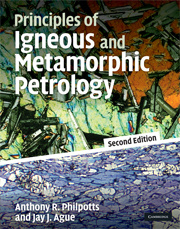Book contents
- Frontmatter
- Contents
- Preface
- Acknowledgments
- List of units
- 1 Introduction
- 2 Physical properties of magma
- 3 Intrusion of magma
- 4 Forms of igneous bodies
- 5 Cooling of igneous bodies and other diffusion processes
- 6 Classification of igneous rocks
- 7 Introduction to thermodynamics
- 8 Free energy and phase equilibria
- 9 Thermodynamics of solutions
- 10 Phase equilibria in igneous systems
- 11 Effects of volatiles on melt equilibria
- 12 Crystal growth
- 13 Isotope geochemistry related to petrology
- 14 Magmatic processes
- 15 Igneous rock associations
- 16 Metamorphism and metamorphic facies
- 17 Deformation and textures of metamorphic rocks
- 18 Graphical analysis of metamorphic mineral assemblages
- 19 Geothermometry, geobarometry, and mineral reactions among solid solutions
- 20 Mineral reactions involving H2O and CO2
- 21 Material transport during metamorphism
- 22 Pressure–temperature–time paths and heat transfer during metamorphism
- 23 Origin of rocks
- Answers to selected numerical problems
- References
- Index
16 - Metamorphism and metamorphic facies
- Frontmatter
- Contents
- Preface
- Acknowledgments
- List of units
- 1 Introduction
- 2 Physical properties of magma
- 3 Intrusion of magma
- 4 Forms of igneous bodies
- 5 Cooling of igneous bodies and other diffusion processes
- 6 Classification of igneous rocks
- 7 Introduction to thermodynamics
- 8 Free energy and phase equilibria
- 9 Thermodynamics of solutions
- 10 Phase equilibria in igneous systems
- 11 Effects of volatiles on melt equilibria
- 12 Crystal growth
- 13 Isotope geochemistry related to petrology
- 14 Magmatic processes
- 15 Igneous rock associations
- 16 Metamorphism and metamorphic facies
- 17 Deformation and textures of metamorphic rocks
- 18 Graphical analysis of metamorphic mineral assemblages
- 19 Geothermometry, geobarometry, and mineral reactions among solid solutions
- 20 Mineral reactions involving H2O and CO2
- 21 Material transport during metamorphism
- 22 Pressure–temperature–time paths and heat transfer during metamorphism
- 23 Origin of rocks
- Answers to selected numerical problems
- References
- Index
Summary
INTRODUCTION
Metamorphism is the sum of all changes that take place in a rock as a result of changes in the rock's environment; that is, changes in temperature, pressure (directed as well as lithostatic), and composition of fluids. The changes in the rock may be textural, mineralogical, chemical, or isotopic. These changes proceed at varying rates, so time is an important factor in metamorphism. Any kind of rock can be metamorphosed; the starting rock is called the protolith. Common protoliths include the spectrum of igneous rocks from ultramafic to felsic, as well as sedimentary rocks such as sandstones, alumina-rich shale (pelite), and carbonate rocks (limestone and dolostone).
In its broadest sense, metamorphism includes the entire range of changes that take place between the zone of weathering and the zone in which melting gives rise to magmas. Traditionally, however, the low-temperature changes associated with weathering and the lithification and diagenesis of sediments have been omitted from the study of metamorphism. Typical metamorphic reactions take place at temperatures above 150 to 200 °C. At the highest temperatures, metamorphism gives way to magmatic processes where partial melting produces migmatites, mixed igneous–metamorphic rocks. Average continental crust starts melting under water-saturated conditions around 1000 °C at low pressures, but this temperature decreases with increasing pressure, dropping to 650 °C at 0.5 GPa (Fig. 11.7). The water-saturated beginning of melting of granite marks the upper temperature limit of metamorphism in many regions, because the latent heat of fusion provides an enormous heat sink.
- Type
- Chapter
- Information
- Principles of Igneous and Metamorphic Petrology , pp. 414 - 427Publisher: Cambridge University PressPrint publication year: 2009



